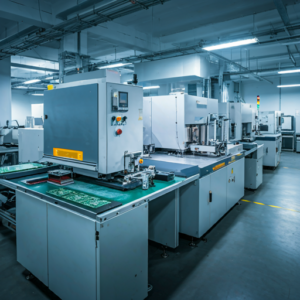目录
ToggleWhat are SMT lines?
Surface mount technology (SMT) lines are tools used to assemble parts on Printed Circuit boards (PCBs). This process is fully automated which increases the efficiency and precision of key factors during production. Join me as we dive deeper into the realm of surface mount lines.

Major Components and Equipment in SMT lines.
The SMT lines consist of 4 main components or equipment that work together to assemble PCBs. Each component plays a vital role when it comes to ensuring precision speed and reliability. Below are the essential equipment and the roles that they each play:
Stencil Printers
Stencil printers are very important in SMT lines as they provide precision. Their role is to apply the correct amount of solder paste accurately on the PCB board. This ensures a proper connection and bond between the board and the components. Precision is important in this step because excess or insufficient solder paste can easily lead to defects.
Pick-and-Place Machines
A pick-and-place machine is basically an automated robot that is responsible for picking the various components from the trays or feeders and placing them on a PCB board.
Reflow Ovens
These ovens are used to gradually heat the PCB board and melt the solder paste in order to create a bond between the components and the PCB board. The temperature must be controlled to avoid thermal damage to any of the components.
Inspection Systems
Inspection is usually the last step in the assembly process. The inspection systems are responsible for identifying defects or any errors during assembly. Some inspection systems use cameras and image processing algorithms to check the placements of the various components.
Each of these components is vital when it comes to surface mount production lines. They work together to ensure precision, efficiency and quality control.
Technological advances in SMT Lines
The SMT lines have experienced some significant technological advancements. This has been brought by the need for faster production speeds, higher efficiency, and accuracy. Let’s take a look at the recent technological advances and their impacts.
Automation
Automation has massively improved the SMT lines some might even say that it has been the backbone of technological advancements in surface mount technology lines. Automation ensures that all the tasks are completed accurately and precisely within the shortest time possible. Automation reduces the chances of defects, which could be costly and time-consuming.
AI integration
AI has been a game changer in SMT lines. It’s now being used to predict when the machines need to undergo maintenance, process optimization, and in some cases real-time decision-making. AI predictive maintenance reduces the chances of unplanned downtime by anticipating when a part or machine will need servicing or replacement. This helps production run smoothly
AI can read and interpret data almost immediately, which means that it can adjust the machine in real-time making it capable of placing the components and soldering accurately. Ensuring high-quality standards.
SMT lines are designed to produce electronic components within a short period of time. They reduce human error, and running costs and maximize production yield. SMT lines offer unmatched advantages as compared to traditional Through-hole technology
0